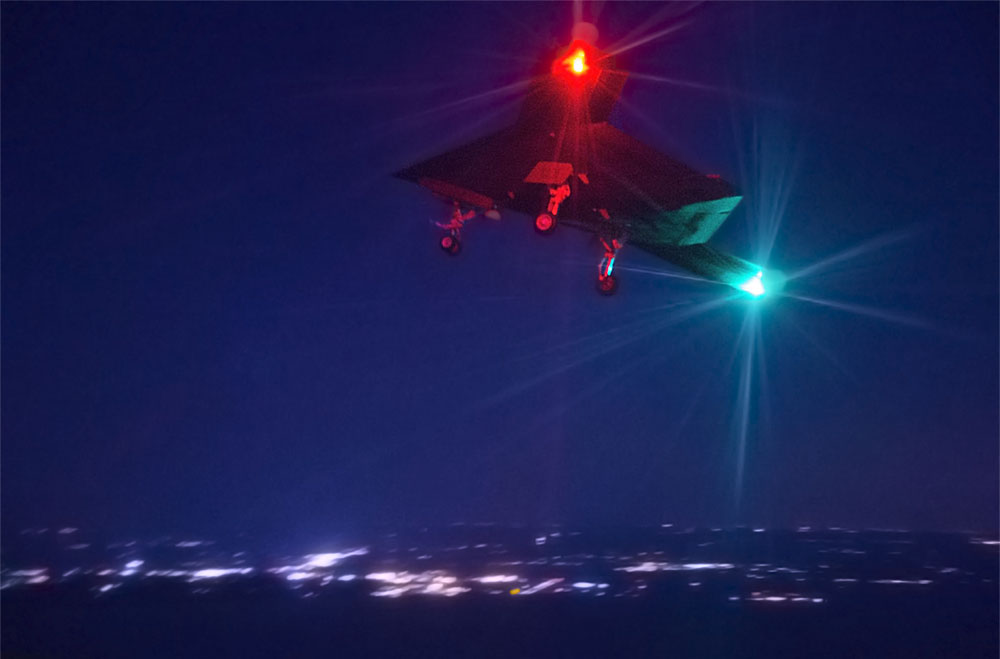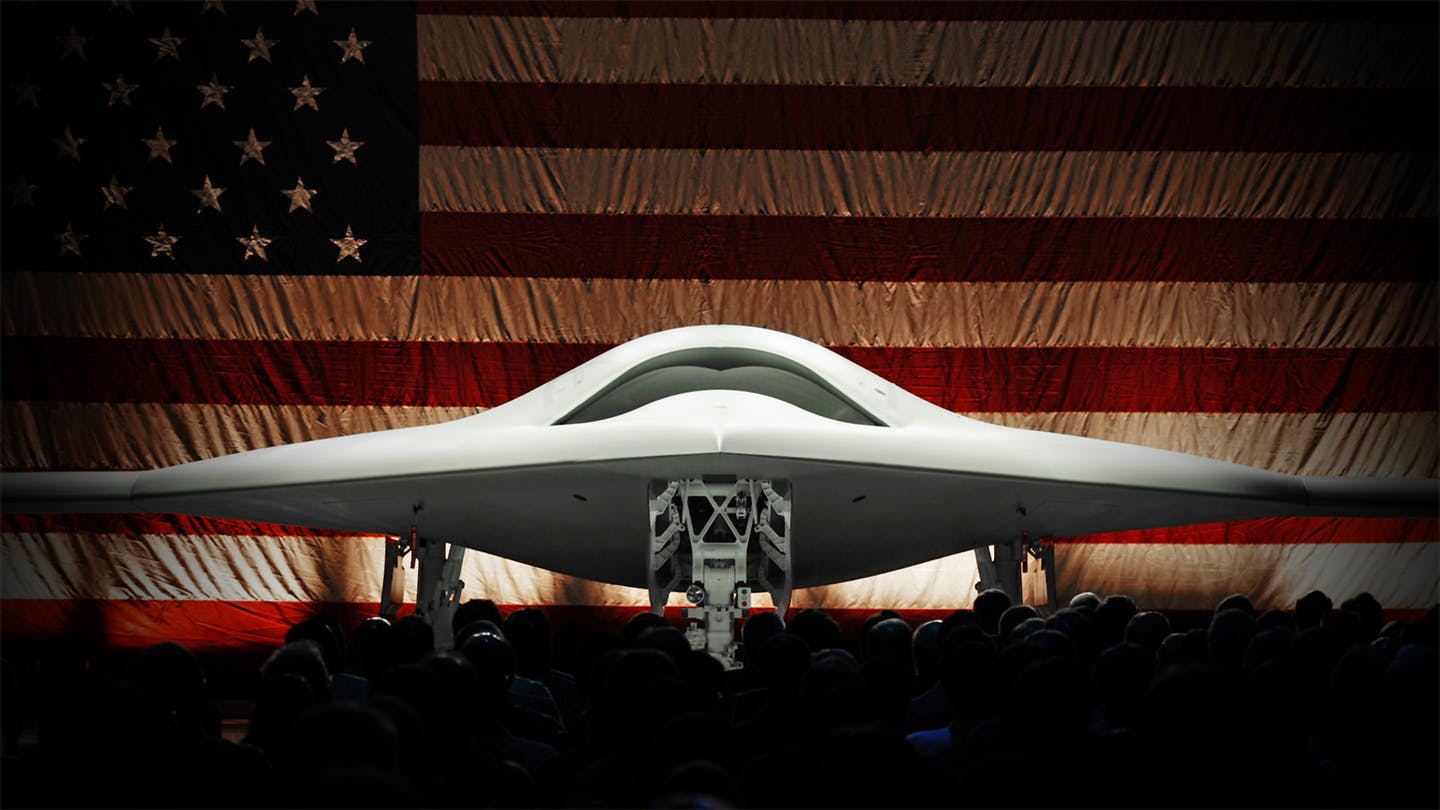The United States Air Force appears to have passed on the greatest leap in air combat capability since the advent of the jet engine—or at least that’s how it looks.
Unmanned military capabilities are all the rage these days, with concepts ranging from insect-sized flying drones, to unmanned sub-hunting patrol boats, to notional pilotless hypersonic aircraft. Yet for some reason, the Air Force seems interested in nearly every application of unmanned warfare but the most relevant one of all, the type that could effectively and efficiently replace budget-busting tactical fighter aircraft while also leapfrogging our potential enemies when it comes to air combat capabilities for decades to come.
The concept in question is not nearly as exotic as some may want you to believe. In defense terms, it is a relatively simple proposition: Build a stealthy, flying-wing unmanned aircraft similar in size to current manned fighters and design them to strike fixed targets deep inside highly defended airspace.
Beyond this rudimentary but critical capability, these aircraft should also be designed to interact with one another and sense the battlefield around them using existing sensor technology, communications concepts and computing power. This will allow them to react to unplanned threats and even work as a team to avoid or destroy these threats and other targets of opportunity with inhuman efficiency. This package of capabilities is commonly referred to as an Unmanned Combat Air Vehicle, or UCAV.
Before we dive in, let’s define a critical set of terms relevant to unmanned military vehicles:
- Man-in-the-Loop — A person is actively controlling the vehicle via a direct control interface. Examples of this concept are Predator and Reaper unmanned aircraft, which have pilots looking at a screen showing the aircraft’s forward view and flying it in a traditional sense. Navigational and tactical choices are made by the vehicle’s human controllers entirely.
- Semi-autonomous — The vehicle works on autopilot and follows commands that are pre-programmed or given to the vehicle via a desktop computer-like interface. The vehicle may have a certain amount of artificalintelligence, but it will ask for approval or direction before making key decisions. TheRQ-4 Global Hawk is a semi-autonomous vehicle.
- Autonomous — The vehicle goes about its mission without any real-time human direction. Navigational and tactical decisions are made solely by the vehicle based on preprogrammed software and mission parameters. Such a system could find, fix and finish a target without external direction by a human controller.

Chapter 1:
The Very Public Birth of the Modern UCAV
You may think truly pilotless robotic flying machines—ones that can replace manned fighter and attack aircraft—sound fantastical. You would be wrong. In fact, this basic capability was proven over a decade ago in the guise of a Boeing Phantom Works and DARPA-led program that centered on a pair of technology demonstrator aircraft, designated X-45A.
These unmanned aircraft looked alien at the time, but they are actually similar in appearance to the UCAV designs emerging today. The X-45A was a tailless aircraft with cranked stub wings and a trapezoid-shaped fuselage. The aircraft had low observable (stealth) features and weapons bays that would allow them to drop small GPS guided munitions during testing. Overall the X-45s were smaller than what a production model UCAV would look like, but as technology demonstrators used to prove that the networked UCAV concept could work, they were far beyond adequate.
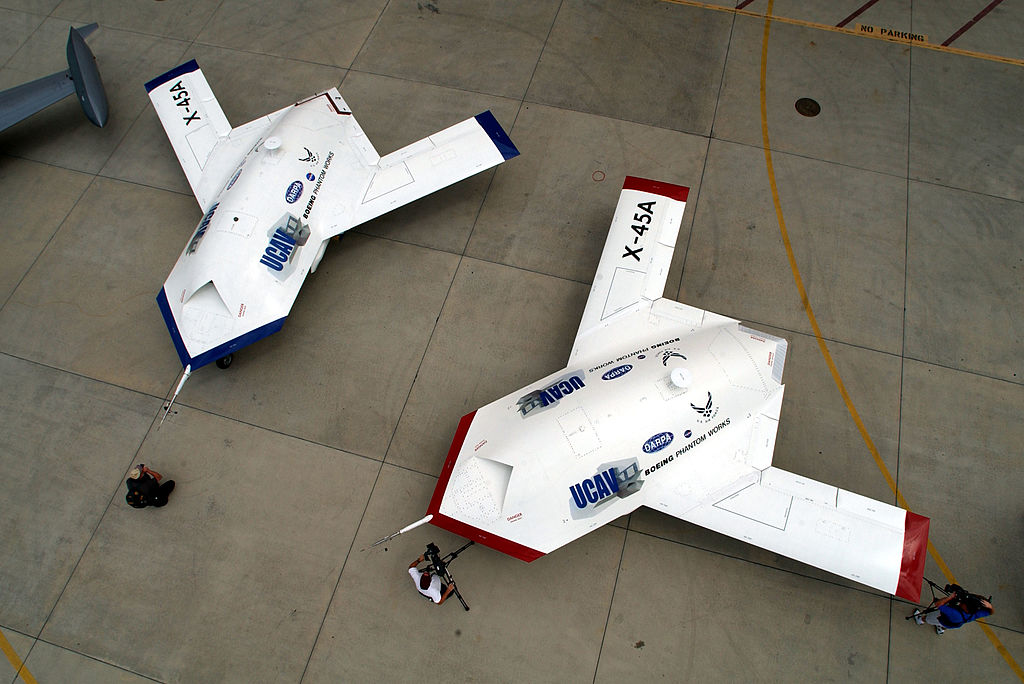
The idea behind the program was not just to fly a stealthy drone remotely via a semi-autonomous command and control interface, but to prove these jets could work together with minimal direction, reacting as a team to their combat environment and surviving to fight another day after completing their objectives.
Instead of a being flown by a pilot in front of a console, like the MQ-1 Predator and MQ-9 Reaper, the X-45s would run via a point-and-click desktop interface, and in some cases, without any human commands at all. The X-45s would be told to perform various tasks, head to a certain area or enter into certain modes. The vehicles themselves could ask for permission to perform certain critical actions or to respond to a particular situation, and the threshold for the aircraft’s own artificial intelligence level and decision making authority could be set according to each mission’s goals.
Boeing’s control software for the X-45s was called DICE, or Decision Mission-Control Software. The software allowed ground operators to guide the X-45’s mission from anywhere in the world, and it allowed both X-45A aircraft to work as a team to accomplish their mission via leveraging a set of algorithms, onboard sensors and communications data links.
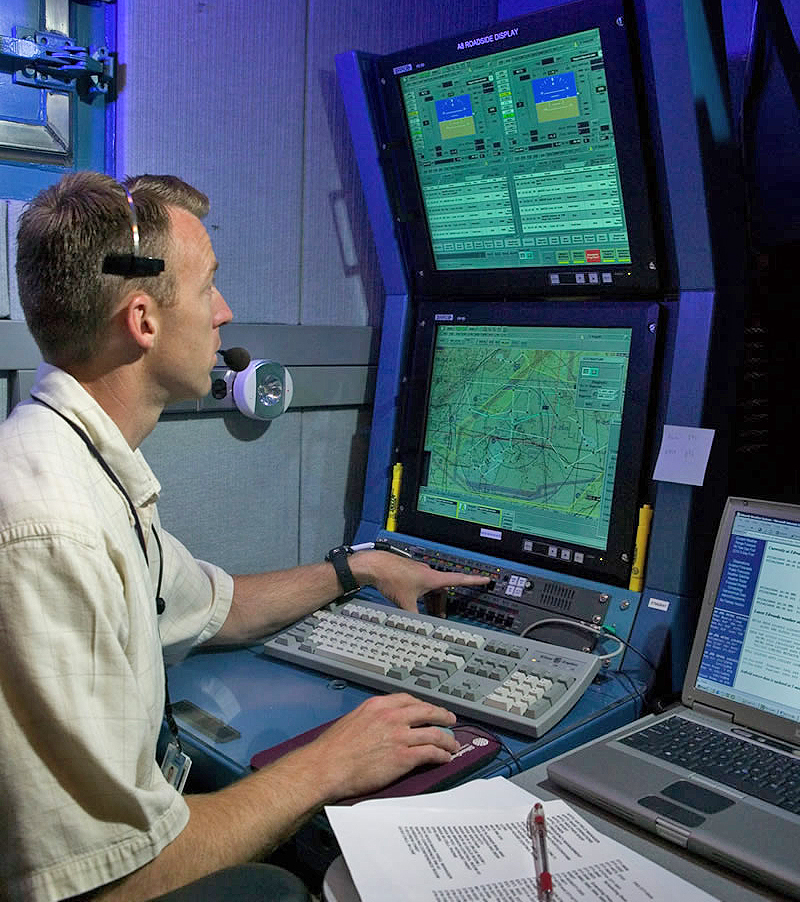
Chapter 2: Introducing
Drone Swarms
The first X-45 flight took place at Edwards Air Force Base on May 22nd, 2002, and the second example flew six months later. The aircraft themselves were impressive, but the DICE software Boeing built to control them was even more so. Together, they were the first publicly disclosed operational progenitor of the flying UCAV “swarm” concept as we know it today. This is where multiple unmanned aircraft interact together autonomously to accomplish tasks at incredible speeds via a cloud-like “collective” computer mind. The concept has become a common one in defense circles today, but in the early 2000s it was still the realm of science fiction.
During testing, the X-45s quickly proved they could not only fly together as a single formation with a high level of autonomy, but that they could strike targets while doing so. By early 2005, the pair were executing mock combat missions as a single integrated unit. As testing progressed, program managers at Boeing and DARPA were sure they were on the precipice of a new era in air combat, one of untold bounds and incredible marketability. The idea was that if the X-45s could prove their mettle in challenging tests, throngs of full-sized UCAVs could be flying operationally by the turn of the decade. A move that would shatter the decades-long development times of much more costly manned fighter and attack aircraft.

On the program’s 50th test flight, the aircraft were slated to prove just how promising their new capabilities are. The X-45s were flown over a simulated enemy battlefield with autonomous control and decision making largely there own. Suddenly, a simulated threat radar activated. The pair of networked UCAVs immediately classified the threat and executed a plan to destroy it based on the position of each X-45 in relation to the target, what weapons were available, what each drone’s fuel load was and the nature of the target itself. The calculations happened in a blink of an eye.
One X-45 immediately changed heading to attack the virtual SAM site while asking for permission to do so from the ground operator monitoring the mission. The attack was approved, and the X-45 obliterated the simulated threat with GPS-guided bombs. Then, another threat—one tougher to detect than the first—popped up and was successfully prosecuted with great prejudice by the flying robotic duo.

The test proved that unmanned semi-autonomous tactical aircraft could not only react successfully to unplanned circumstances, but they could do so in such a manner that was in some ways superior to their manned counterparts. Additionally, this test included just two aircraft. Dozens, or even hundreds, of UCAVs could leverage this same cooperative decision making. The potential implications of this new technology were massive.
The crazy thing is that this test happened over a decade ago. Think of what your cell phone looked like in 2005, or your television, and compare that to what they look like now.
While the future looked blindingly bright for UCAVs, against all logic, the great UCAV revolution would be buried without explanation, and with it the promise of an operational and devestating unmanned swarm.

Chapter 3: UCAVs Disppear Into Oblivion
So what happened to the X-45 program? Having ramped up in the early 2000s, it quickly morphed into a joint initiative called the Joint Unmanned Combat Air System, or J-UCAS for short. The Navy had been running its own, albeit less advanced UCAV technology demonstrator program with the Northrop Grumman X-47A. With J-UCAS, both programs were brought under the same umbrella and would be forced to share some information, although each team was able to go about achieving their own distinct goals. Still, a fly-off between the two defense giants for a single full-scale, joint service UCAV was on the horizon.
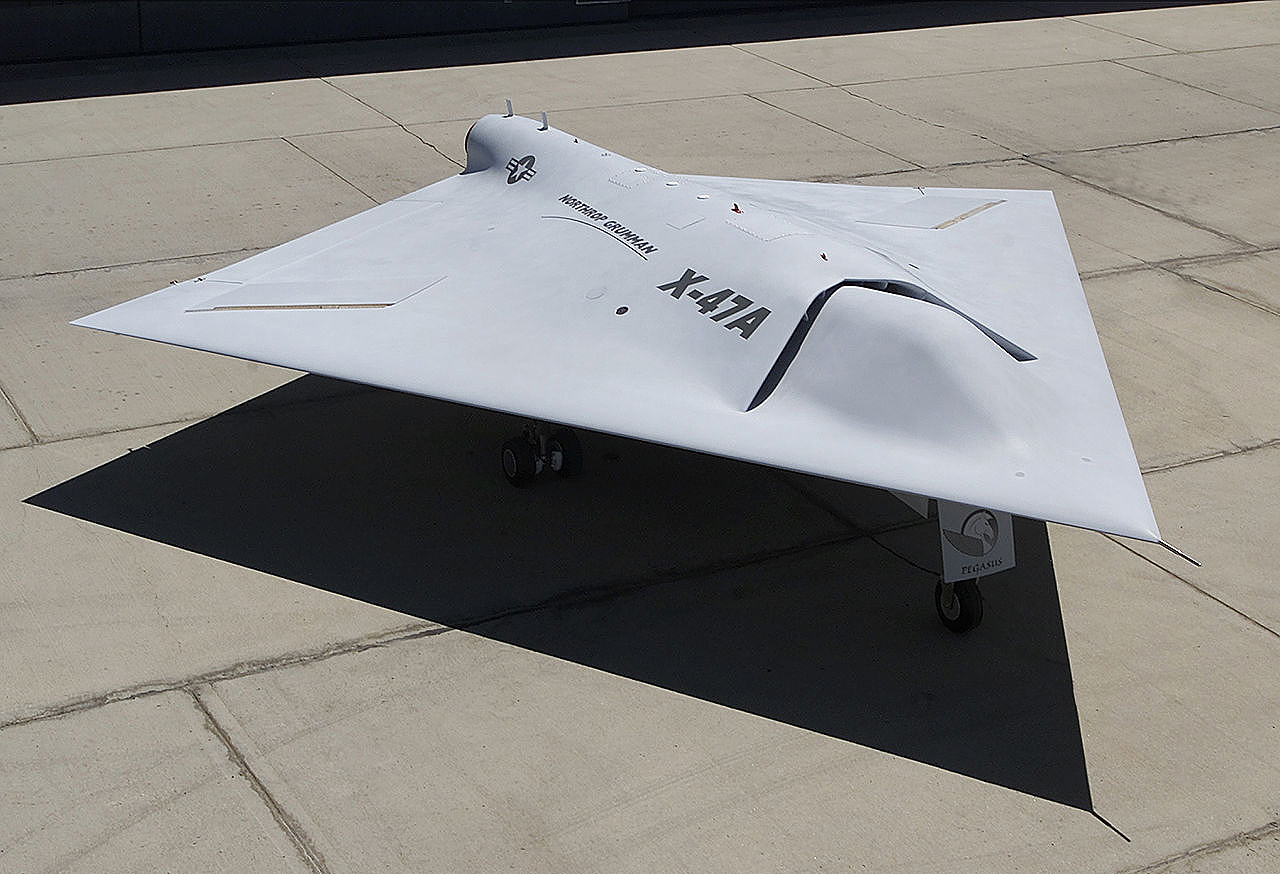
By 2005, two years after the J-UCAS program launched and the same year Boeing proved just what its X-45s could do as a team, DARPA exited the effort. The J-UCAS program was then transferred entirely to the USAF and the Navy. This made some sense, as a supposed fly-off for a full sized UCAV would be administered by the two services jointly, with the hopes that a single operational UCAV design could be procured for both services toward the end of the decade.
Then in 2006 this Navy-Air Force consortium suddenly imploded, with the USAF dropping out of the program entirely. This was an incredibly peculiar move as the technology clearly had a wide array of applications that could have huge game-changing impacts on the modern battlefield. The strangest thing about the USAF’s sudden exit is that they did not proceed to start their own UCAV development program afterwards. From this point on it was almost as if the technology did not exist in the Air Force’s eyes.
How could the USAF turn its back on such a monumental advance in warfare? It seems nearly unthinkable if not downright reckless. Was this move a result of the success of the X-45 team and the resulting threat that this new capability posed not just to the USAF’s historically insular fighter pilot culture, but also to the service’s massive strike-fighter program that was just spinning up, the F-35? Or was the USAF’s burial of a UCAV initiative the result of the fact that something else very similar already existed in the classified world?
It is quite possible that either or even both possibilities were true.
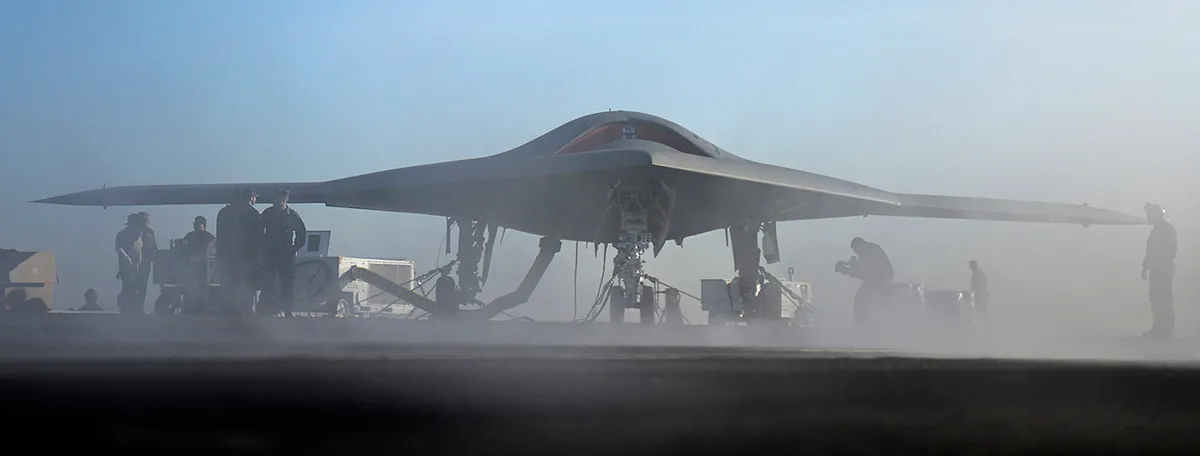
Chapter 4: The Navy’s UCAV Initiative Soldiers On
The Navy proceeded with its own UCAV program after the demise of J-UCAS, but only as a larger technology demonstration program known as N-UCAS. Boeing would compete with Northrop Grumman for this contract, and eventually Northrop Grumman would win the bid. This gave birth to the now famous full-scale X-47Bs test aircraft.
These aircraft would go on to prove themselves as capable of amazing feats, including landing, launching and operating from the deck of an aircraft carrier in 2013 as well as refueling autonomously in mid-air in 2015.

These series of hugely successful tests has set the Navy up to field its first operational unmanned aircraft aboard its aircraft carriers in the not so distant future. This aircraft will be known as the MQ-25 Stingray or the Carrier-Based Aerial Refueling System (CBARS). The Navy’s move to field a less ambitious unmanned aircraft concept, one more focused on aerial refueling and working as a sensor platform than an advanced deep-striking UCAV is a misguided one, but that is a whole other story. Still, at the very least CBARS is a step in the right direction for the Navy.
The fact is that the Navy has been more conservative than the USAF when it comes to its tactical aircraft fleet in recent decades. The Navy’s flying branch has taken a “platform” approach to air power, focusing on efficiency, affordability, multi-role utility and commonality for its tactical aircraft fleet over a focus on top-of-the-line capabilities. Hence the F/A-18 Hornet’s nests that are modern American supercarriers. The Super Hornet has become a one-size-fits-all solution for the Navy, who still has not introduced a stealthy airframe to its carrier air wings till this very day. The F-35C is slated to finally provide this capability some 25 years after it was originally promised to the Navy in the form of the long-defunct A-12 Avenger.
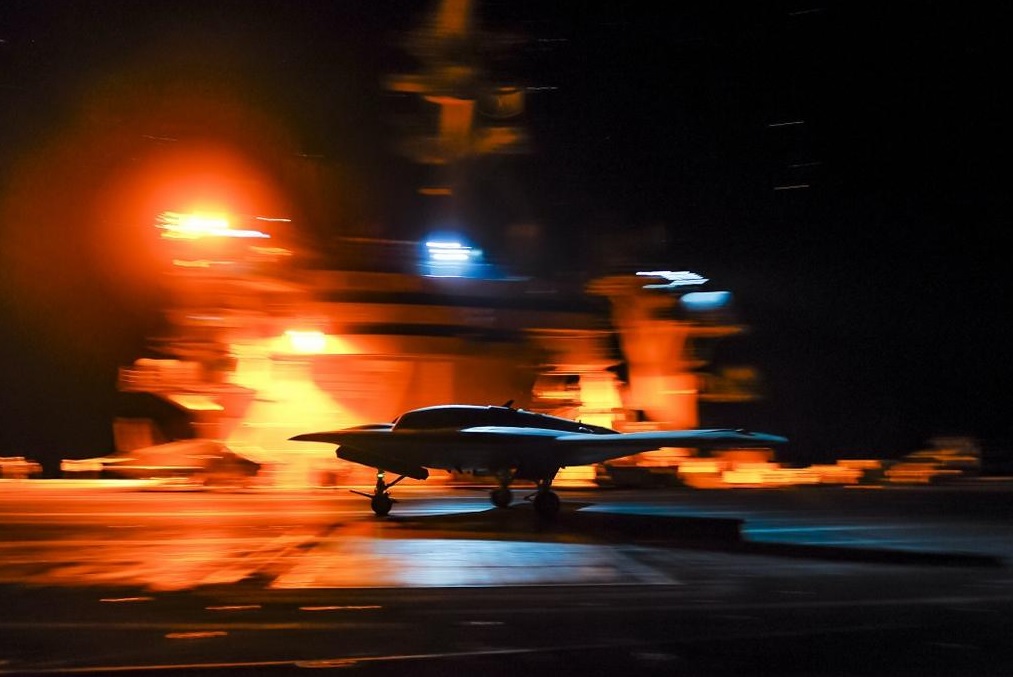
There are also the unique challenges that come with operating unmanned systems from the bustling deck of a supercarrier that large airfield-based unmanned systems don’t have to contend with. Still, in the long run UCAVs are ideally suited for the carrier environment and mission as much, if not more so, than any other. Yet in the nearer-term, the USAF was a much more logical candidate to field advanced UCAVs in large numbers early on than the Navy.
Chapter 5: A Skunk Works Surprise
A year after the USAF dropped out of J-UCAS, seemingly without a replacement, a strange thing happened. In 2007, a stealthy flying wing unmanned aircraft was spotted operating at Kandahar Airfield in Afghanistan. This mystery aircraft was originally dubbed the “Beast of Kandahar” by the defense press.

At the time, it wasn’t hard to figure out its overtly logical purpose. There is no need for a stealth drone to operate in uncontested airspace like that above battlefield Afghanistan. No, this shadowy aircraft was built to spy over enemy and even semi-friendly countries alike, such as Iran and Pakistan—and that was exactly what it was doing.
Although details were slow were emerge, this aircraft was eventually unmasked as the RQ-170 Sentinel, a Lockheed Martin Skunk Works product used by the CIA and the USAF. Years later, the aircraft would become famous for spying on Iran’s nuclear facilities, helping to locate Osama Bin Laden, secretly watching him from on high as he paced around his prison-like yard at his Abbottabad compound, as well as for falling into Iranian hands almost completely intact.

It was quite peculiar that Lockheed Martin had been seemingly totally absent, at least publicly, from the Pentagon’s UCAV initiatives during the early and mid-2000s. Yet we now know that they not only had flown a UCAV sized, deep penetrating, stealthy flying wing unmanned reconnaissance aircraft, but that it was fully operational and flying over some of the most highly defended places in the world during this same period of time. Additionally, by 2007 it was doing so in broad daylight with little regard for secrecy or operational security.
You can read all about the likely origins of the RQ-170 here and here, but its exact history is less important than the fact that it exists at all. While Northrop and Boeing were publicly giving birth to the modern UCAV concept, and battling over high-profile testing contracts in hopes of supplying the Navy and Air Force with hundreds of UCAVs one day, the Skunk Works had not only tested similar systems, but had at least one of them fully operational and doing work in some of the nastiest airspace on the planet.
As far as we know, the RQ-170 is only equipped with sensors, and even if it had a weapons bay it would be a very small one. But that doesn’t mean another variant of this design, either the same size or larger, could have also been built and at least tested. In fact, it is pretty absurd to think otherwise. Remember, at its very least, a UCAV’s core mission would be flying to a set of coordinates, dropping a GPS guided bomb or two, and then fly back to its base. This is a far simpler mission than penetrating enemy airspace, persisting there for hours while directing various sensors to spy on specific locales on the earth below, and returning home safely to do it again another day.

With this in mind, retrofitting basic UCAV capabilities into an existing stealthy flying wing surveillance drone design like that of the RQ-170 seems like a glaringly logical move. In fact, the Skunk Works agrees with this as they have put forward an enlarged Sentinel design called the Sea Ghost in an attempt to fulfill the Navy’s UCAV needs. There has also been rumors of “Super Sentinels” already existing which could be an operational UCAV evolution of the RQ-170, and the missing link between the navalized Sea Ghost concept and its more diminutive spying progenitor.
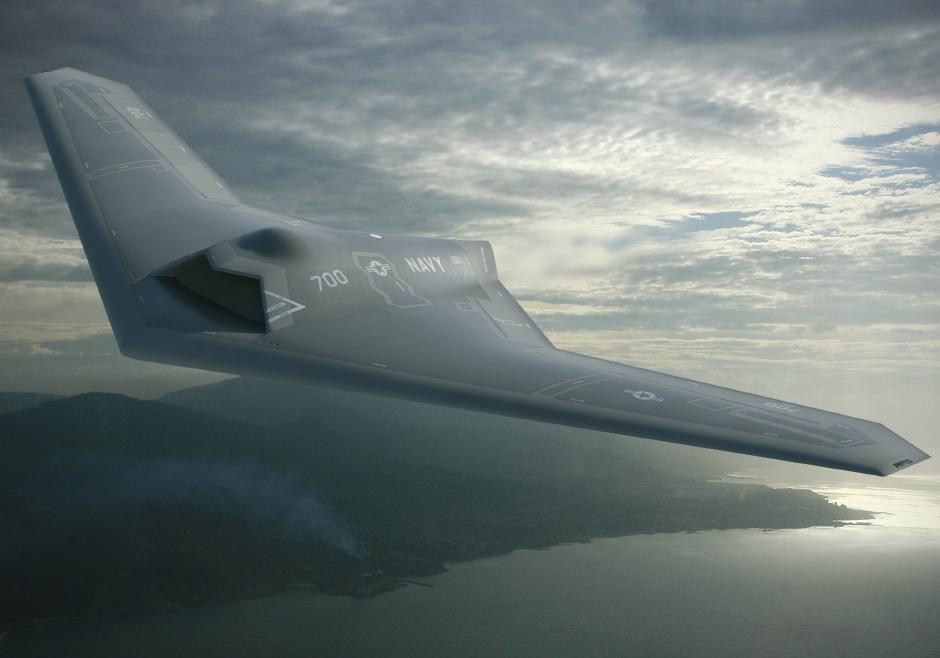
Chapter 6: The F-117 Nighthawk retires without a successor
Another interesting event that occurred around the same time as the first sightings of the RQ-170 was the somewhat ambiguous retirement of the F-117 Nighthawk, America’s first stealth strike aircraft. Even at the time of its retirement in 2008, no other known stealthy tactical aircraft existed that could drop heavy-hitting 2,000-pound precision guided bombs.
Some officials said that the F-22 would take over a piece of the Nighthawk’s mission, but the Raptor is limited to just a pair of the smaller 1,000-pound Mk83/GBU-32 JDAMs. Only the B-2, of which just a handful are available for combat at any given time, can match and exceed the F-117’s destructive power while surviving deep over enemy territory. In that sense, the F-117 program represented a unique and proven capability, one that seems far too important for the USAF to just give up. This is especially considering that the decision was made during the height of the Bush Administration defense spending splurge. Maybe the oddest part about the F-117’s retirement was that the USAF never even complained.

The F-117’s mission was deep precision strike. For the vast majority of its career it accomplished this via the use of laser guided bombs. F-117 “Bandits” (pilots) ability to navigate to their targets at night, without radar, and employ the jet’s pair of 2,000-pound laser-guided bombs was an artform prior to the introduction of GPS.
During the tail-end of its career, the F-117 force was able to drop GPS-guided Joint Direct Attack Munitions. With this new upgrade the F-117s could simply fly to a point and release these weapons with a high degree of accuracy, regardless of the weather conditions. Once again, this is the rudimentary mission of UCAVs, and it begs the question: Was the F-117 replaced by a small fleet of stealthy operational UCAVs that existed in the classified world much like the F-117 did for nearly a decade before its eventual disclosure? The F-117 program would have been an ideal model on which to base a clandestine UCAV program, and since UCAVs don’t require constant training flights like a similar manned system does, they can stay hidden much easier.
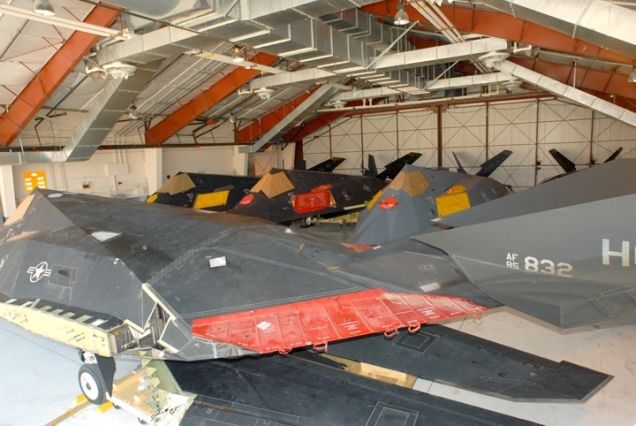
Since its retirement the F-117 fleet has been maintained in a regenerative state, and even occasionally flown at the shadowy Tonopah Air Force Base, which is also the likely operational home of a pocket UCAV force—if it were to exist. Maybe the F-117s were kept in such a state to hedge against what was still a very new, evolving and untested technology. Now, nearly a decade later, with the largely mummified F-117 force potentially getting scrapped once and for all, will a disclosure of a small UCAV fleet follow? The F-117 was first disclosed along a similar timeline in 1989.
Chapter 7: The Ramifications of the Unknown
With all this in mind, it is possible that the UCAV revolution happened in the depths of the “black projects” world even before it happened in the unclassified world. If this is true, Lockheed’s Skunk Works were almost certainly the dark shepherds that brought forth this new and devestating technology.
On one hand, this would seem like a dramatic example of how isolated the classified weapons development world is from the non-classified one, and of how many billions of dollars are needlessly wasted developing parallel capabilities. On the other, if the USAF had chosen to watch parallel capabilities develop, Lockheed’s classified stealth unmanned aircraft developments could have acted as an independent control variable against UCAV developments occuring in the unclassified world. Once one effort had pulled ahead in its capabilities, a down-select would likely have been made. In this case, that selection would have been whatever was going on outside of the public’s, and to a large degree Washington DC’s eyes.
Could this situation have been the catalyst for the USAF’s dropping out of J-UCAS in 2006, just a year before the RQ-170 suddenly emerged? Did the USAF continue to invest in the UCAV space via the Skunk Works, albeit in the realm of deep classification, to a point that would justify the F-117s retirement?

The question remains: Why hide the existence of even a pocket force of operational UCAVs, considering that the world has watched the Navy’s X-47B not only fly, but operate from a carrier and even refuel autonomously? Additionally, the X-45s proved the UCAV concept for the entire world to see years prior. With the B-2, the USAF has the ability to strike with 2,000-pound and even heavier-hitting weapons deep into defended territory. so it’s not like hiding a small force of stealthy UCAVs would make the enemy feel as if well defended targets were not already at risk of attack by US forces.
Then agian, maybe the USAF wasn’t primarily hiding the UCAVs from the enemy at all, but instead from the government and taxpayers who paid for them in the first place.
Classifying such a game-changing and relevant capability doesn’t just distort the important and very expensive weapon system procurement choices being made by Congress, the White House and the Pentagon. It also skews America’s defense strategy as a whole and all the long-term force planning that goes along with it.
It doesn’t seem like an uncommon practice for the powers that be to classify programs in order to protect inferior non-classified programs from having direct competition. Some weapons programs are also hidden in the classified world to prevent special interests from trying to cancel them in favor of other non-classified programs—ones that are less capable but more lucrative. Either way, the losers in such practices are America’s ability to get the best force for its money, and the warfighter’s chances of success in a conflict. That is, if you think the primary goal of America’s armed forces is to fight and win wars, not create jobs or to support particular industries.

Clearly, if UCAVs were flying even in smaller numbers, and their networked hive mind could be proven on a larger and more advanced scale than what the X-45 proved over a decade ago, such a system would hugely threaten the F-35 Joint Strike Fighter. The F-35’s primary missions include deep strike, surveillance and “destruction of enemy air defenses,” or DEAD. These are the exact same as those of a UCAV. In many ways, the UCAV could execute these missions far more efficiently and ferociously than their costly manned counterparts.
Chapter 8: The Potential Advantages of UCAVs
The USAF’s fighter aircraft age catastrophe and pilot shortage crisis, as well as the tactical challenges that the force faces on the battlefields of tomorrow, could largely be solved by a UCAV force. Even the USAF’s failing fighter budget could be cured by procuring, at least partially, UCAVs instead of expensive and inflexible manned systems that represent a half century-long financial and strategic commitment.
It may be uncannily unpopular to the USAF’s pilot dominant culture, and even to military and aviation aficionados, but UCAVs have a laundry list of potential advantages over manned fighters and attack aircraft. In fact, they could revolutionize the very idea of what an Air Force looks like, how it trains, how it fights, and the money needed to sustain its capabilities.
Here are some of the major potential benefits of stealthy UCAVs based on general concepts that have coalesced in recent years:
– They have lower acquisition prices than modern fighters:
You can build many more UCAVs for the same price of an advanced stealthy manned fighter. A four-to-one or even six-to-one ratio has been floated depending on how advanced the UCAV is. Doing so would break the cycle of ever increasingly expensive fighters eating up the DoD’s budget and add greater end-strength to the rapidly shrinking Air Force’s tactical jet inventory.
This issue has morphed into an absolute crisis, with a recent Pentagon report stating that the USAF will not be able to afford its fighter jet fleet by the year 2021, just five years from now. In many ways UCAVs offer both a quantitative and qualitative advantage at the same time.
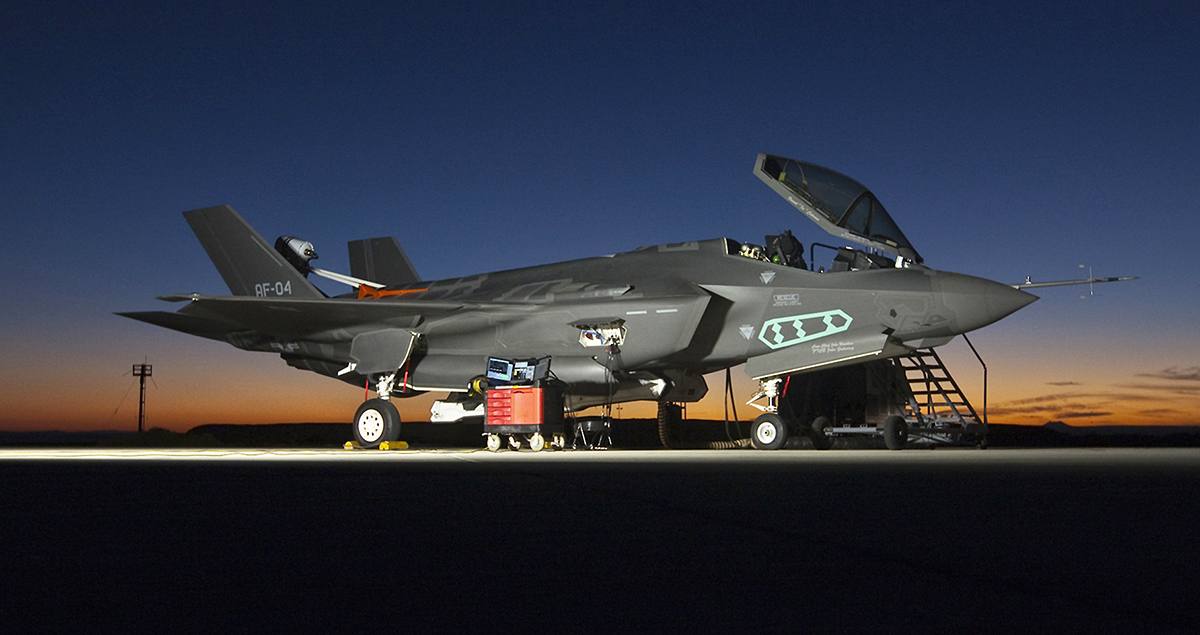
– UCAVs could be rapidly adapted to perform various missions, and a flight of UCAVs can “share” expensive sensors:
With UCAV swarms you do not have to equip every UCAV with the same expensive sensors and subsystems as you have to with manned fighters. Using adaptable open architecture and “plug and play” design philosophies, a group of UCAVs can be outfitted for a particular mission or mission set. By adapting a single airframe for various roles via a series of unique configurations, great cost savings can be realized without greatly hampering the effectiveness of the swarm as a whole.
In a single swarm “package” of UCAVs, you can have some airframes outfitted with advanced radars, some carrying networking, data-fusion and communications hardware, while others can carry highly sensitive electronic emissions sensing gear. Another set can carry bombs and missiles, while others can be outfitted with directed energy weapons (lasers) or advanced jamming equipment. Additionally, some can carry combinations of these capabilities. Because a package of UCAVs can act as a networked swarm and are constantly linked together via data link, each UCAV can share its sensor information with all the other UCAVs in its swarm and in real-time. When all this data is combined, a high-fidelity picture of the battlefield is rendered for the whole swarm to exploit. In other words, a UCAV that has no radar at all, can benefit from other UCAVs outfitted with such systems as if it were its own.
Even working as a small swarm of say six UCAVs, three could be optimized as simple munitions mules, two can operate as sensor craft, and one can be outfitted as an aerial tanker and jamming support platform. Although the munitions mules may not be equipped with a radar or other targeting and situational awareness sensors, they are virtually equipped with them as the swarm’s collecting brain can “see” a fused “picture” of all the UCAV’s sensor information combined.
For missions where you need maximum redundancy, the swam could be made up of all fully outfitted UCAVs with all the bells and whistles, similar to how fighters types are equipped equally today. Not only does such a concept save money while lowering the fiscal risks of combat, but it also allows for new systems to be more easily integrated into an ever changing UCAV force.
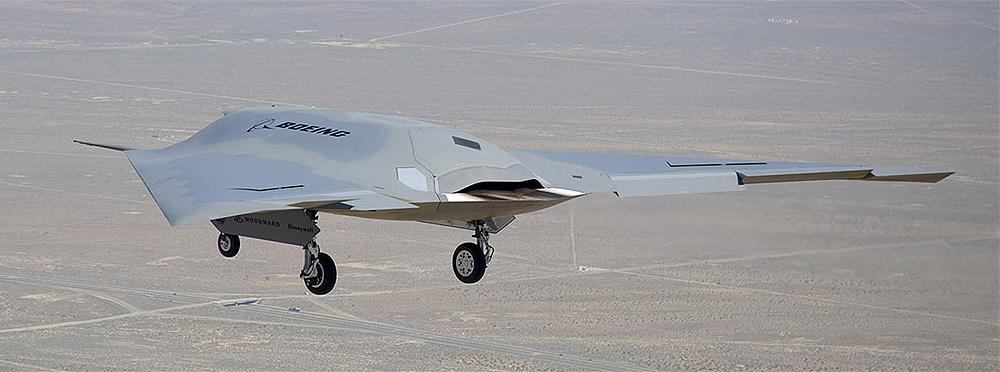
– They possess far greater range and loitering time than their manned fighter jet counterparts:
UCAV concepts generally have double to quadruple the combat radius of their manned progenitors. This is due in part to their lower kinetic and maneuverability requirements, their flying wing designs, and the fact that they don’t have valuable space and payload taken up by a cockpit and life support systems. Considering the anti-access and area-denial issues we face against potential enemies today, this greatly increased range alone makes procuring UCAV technology on a large scale essential.
The F-35A has a combat radius of about 590 miles, which means a vulnerable tanker will have to get within 590 miles of the F-35A’s target to provide gas, or even more of an issue, the jet will have to be based within that distance of its target. In actuality, under real combat conditions the F-35A’s combat radius will likely be further reduced, since the 590-mile figure is a “brochure” metric.
Our potential enemies’ large arsenals of ballistic and cruise missiles means that land-basing F-35s within 590 miles of the enemy’s borders is a non-starter in a real shooting war. China’s long-range strike-fighter, the J-20, is designed to fly out long distances to go after America’s vulnerable flying force multipliers, including tankers and AWACS aircraft. This strategy, which I pointed out right after the J-20 was first photographed, makes total sense for the Chinese. Why take on fighters when you can take them out simply by downing the tankers they are so dependent on or blind them partially by blasting their AWACS out of the sky?
Even the Russia’s next SAM system, the S-500, will have a supposed range of 375 miles, and follow-on versions will only see its engagement envelope even further extended. Thus the F-35’s 590 mile combat radius has a shrinking margin of success against a well-armed peer-state competitor. Seeing as the F-35 is supposed to serve for many decades to come, with the last examples going out of service in 2070, the idea that short-ranged fighters will even be tactically relevant in a decade or two is highly debatable.
The F-35A’s striking distance can be increased by a couple hundred miles via the use of standoff weaponry, but that also somewhat defeats the point of theF-35’s stealthiness to some degree, especially as a conflict progresses, and there are limited stockpiles of these types of highly expensive weapons on-hand at any given time. Additionally, the more very expensive fighter jets the US buys, the less standoff weaponry it can afford to have lying around. Even America’s stockpiles of much less expensive guided bombs and short-range air-to-ground missiles cannot sustain the ongoing limited air campaign against ISIS!
In the end, these factors can put the F-35A, and other fighters for that matter, out of the fight on day one. A UCAV with a range of double or even triple that of the F-35A, while carrying the same payload, does not have this problem.
The ability to loiter very near or even over enemy territory for long periods of time, and survive, has become an invaluable intelligence gathering capability. Aerial reconnaissance in now far more focused on capturing a period of time (RQ-170) instead of a moment in time (SR-71). When it comes to striking targets of opportunity, the same trend has emerged. Staying over a place and waiting for the enemy to expose themselves, and punishing them for doing so, has become a more in-demand service than simply striking fixed targets. Flying-wing UCAVs, with their large fuel loads, aerodynamic efficiency and fuel miserly turbofan powerplants allows them to stay on the scene for hours, not minutes, before needing to be refueled.

Finally, because UCAVs have much longer range they require less tanker support. Less tanker support means less tankers and a smaller overall USAF tanker program, saving billions. In fact, UCAVs could provide their own tanker support via buddy refueling. Doing so would just mean committing more UCAVs, some configured as tankers, in order to take out a particular target set without external tanker support.
-They are more disposable:
You don’t have to build a UCAV to fly 8,000 hours as with manned fighter aircraft, a requirement that adds significantly to an aircraft’s unit and development costs. Instead UCAVs can be designed to last a fraction of that flight time.
The reason for this is that these aircraft don’t have to fly anywhere near as much as their manned counterparts. Nobody really has to train to fly them at all. Computer simulations and modelling, a strong centralized test and development effort and intermittent large-scale air combat exercises will be essential in proving new UCAV tactics and to certify the systems as effective, but beyond that these things can largely sit in a hangar and wait for combat. The days of putting hundreds of hours on a tactical jet airframe a year would be over. As a result, a UCAV could be designed to last a couple thousands hours of flight time or even far less.

-They are expendable:
UCAVs can be ordered to fly into the most dangerous airspace in the world without the potential loss of aircrew being a factor, which can have huge political ramifications both abroad and at home. This also means commanders can take greater risks with greater potential rewards during conflicts and can more freely strike at the heart of the enemy’s ability to wage war.
For instance, instead of very slowly breaking down the bad guys’ area denial and anti-access capabilities from long-ranges using expensive standoff munitions, massive swarms of UCAVs can execute direct attacks on key anti-air warfare targets.
UCAV’s far lower unit cost and simpler manufacturing process, one that can make the most oflarge composite structures and 3D printing, also means they can be replaced more efficiently than manned aircraft. In other words, UCAVs can speed up an air campaign’s intended results compared to manned systems, while doing so at far lower risk.
-They don’t require pilots:
Sure, this is the most obvious feature of UCAVs, but there is more to it than just not risking aircrews in combat. Because UCAVs don’t require pilots, the USAF would need to train less of them. This could not only be a solution to the USAF’s increasingly dire shortage of pilots but it could also mean that the service’s entire fleet of fast-jet and primary training aircraft could be significantly downsized. Such a move would equate to enormous savings when it comes to personnel and aircraft procurement, sustainment and operational costs.
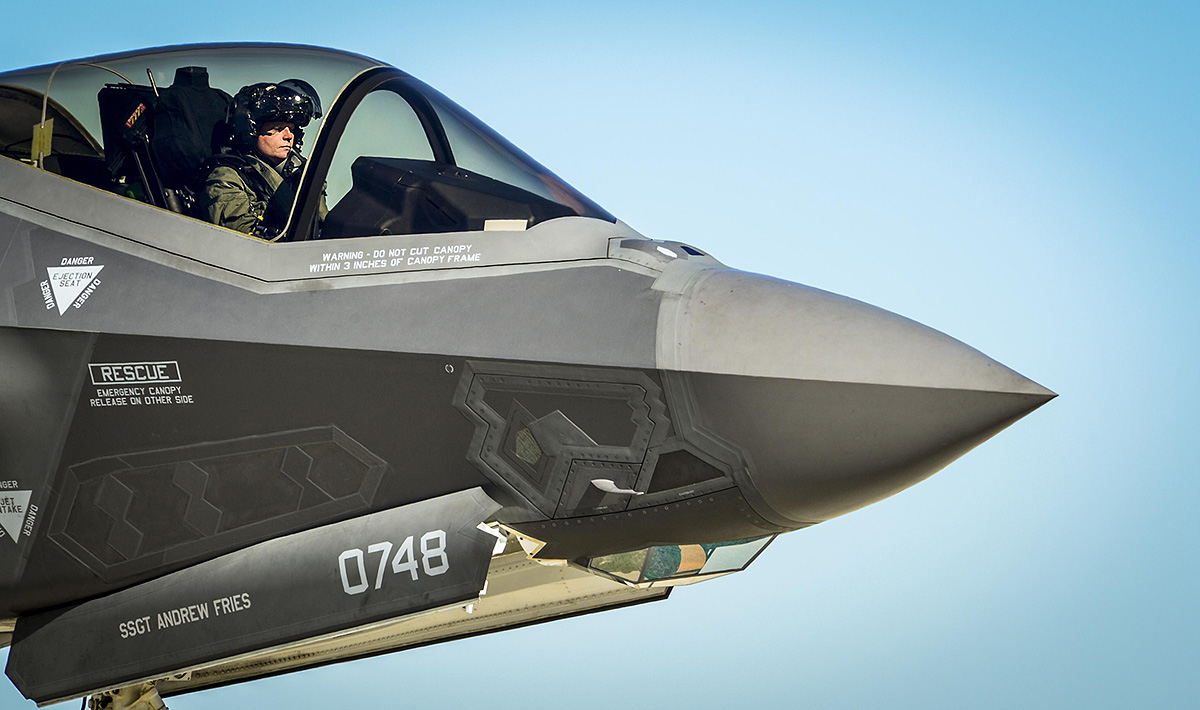
Look at the USAF’s pending replacement program for the T-38C Talon, dubbed the T-X. If the USAF procured UCAVs aggressively how many billions would be saved on new training aircraft purchases simply because they won’t be needed? In fact, there may be no need for a T-X program at all, at least for a couple more decades, as the T-38 fleet could be consolidated and the its life stretched for many more years.
This also underscores how a secret UCAV program, one that could be drastically expanded in the coming years if it were declassified, would make investing into an expensive new jet trainer program a monumental waste of money in the near term.
The truth is that a front-line fighter jet will spend the vast majority of its flying life honing pilot skills, not flying combat missions. This takes massive amounts of fuel, maintenance man hours and parts, and a gargantuan backend support infrastructure. The fact that a UCAV requires none of this really is the concept’s biggest savings opportunity. Simply put, flying skills are not required to be a part of a UCAV’s command and control cadre. There are simply no pilots to train.
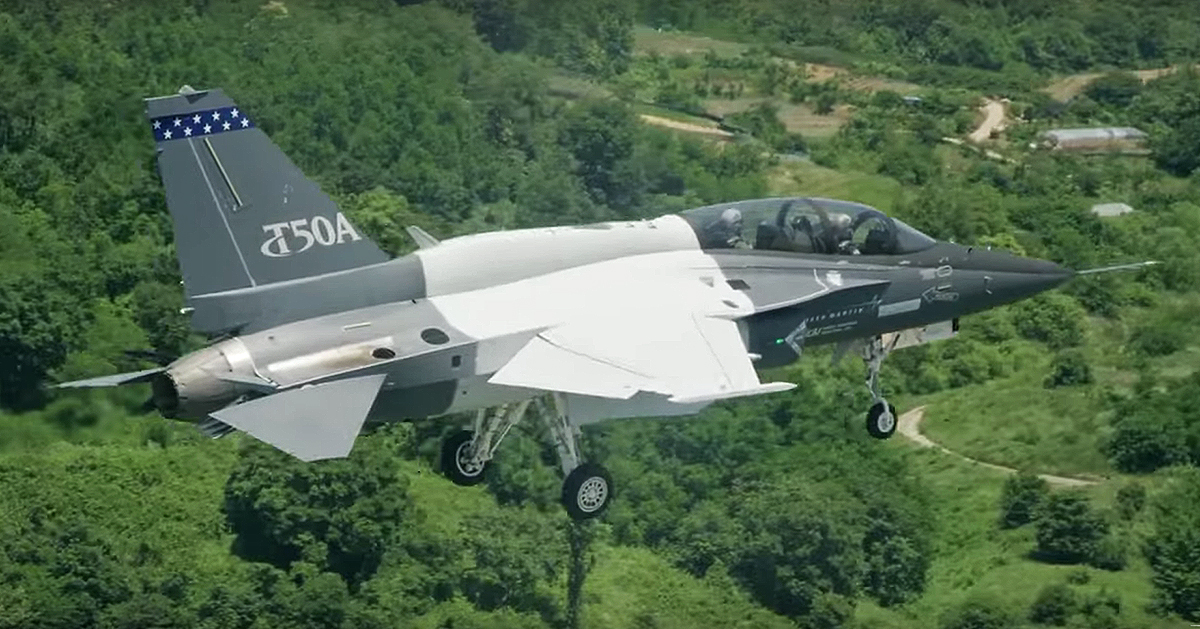
Considering that the lowest cost per flight hour estimates for the F-35 are $32,000, with this number likely being far larger in reality, not having to fly a vehicle regularly at all is a very big deal. Beyond maintenance test flights and limited training and tactics certification exercises, UCAVs can remain in storage until they are needed for combat.
UCAVs also don’t require combat search and rescue forces. If a UCAV is shot down, dozens of combat search and rescue and support aircraft don’t have to attempt a daring rescue of a downed aircrew. This also means less CSAR assets will be needed in inventory. This is a big deal considering the USAF has struggled for well over a decade to fund a new CSAR helicopter. And of course the potential ramifications of more lives being put in danger to rescue a downed aircrew behind enemy lines become a non-factor with UCAVs.

The thing is, the USAF really doesn’t have a good answer when it comes to providing combat search and rescue capability for aircrews that fly aircraft like the F-35, F-22 and B-2. These jets can penetrate hundreds or even thousands of miles (in the B-2’s case) deep into highly contested airspace. Flying CSAR helicopters and their escorts (HH-60s or CV-22s and MC-130s) into such a situation would be ridiculously perilous proposition to say the least. With UCAVs this tactical conundrum vanishes.
-UCAV design and procurement can rapidly adapt to changing tactical realities:
Since they don’t have to have an 8,000 plus flight hour lifespan that will be spread over many decades, new UCAVs with enhanced design features and better low observable qualities can be bought on a regular basis. Such a concept also has the potential to greatly smooth the USAF’s notoriously disgraceful and unsustainable big-ticket weapons procurement process.
Instead of buying an entirely new fighter jet every couple of decades, the service can constantly buy far cheaper UCAV designs in tranches of ever increasing capabilities tailored to match emerging threats in near real-time. This type of procurement concept allows for a far more nimble response to changing tactical challenges, and in doing so it puts America’s potential enemies at a drastically greater disadvantage when it comes to trying to counter our own capabilities.
As UCAVs evolve, older units can be re-roled to perform non “tip of the spear” but still essential duties. These include tanking, acting as communication relays, flying data fusion centers, surveillance platforms and acting as arsenal ships for troops on the ground in lower-threat combat environments. In other words, commanders can use their newest, most updated UCAVs for kicking down the enemy’s door while also using older systems to fulfil other critical but less risky missions where a UCAV’s persistence is still a big plus.
In the end, a UCAV, no matter how stealthy or advanced it is, is still capable of staying aloft for hours with a relatively large payload. As such, older designs will have many uses even after their “first day of war” utility is degraded by the passage of time.
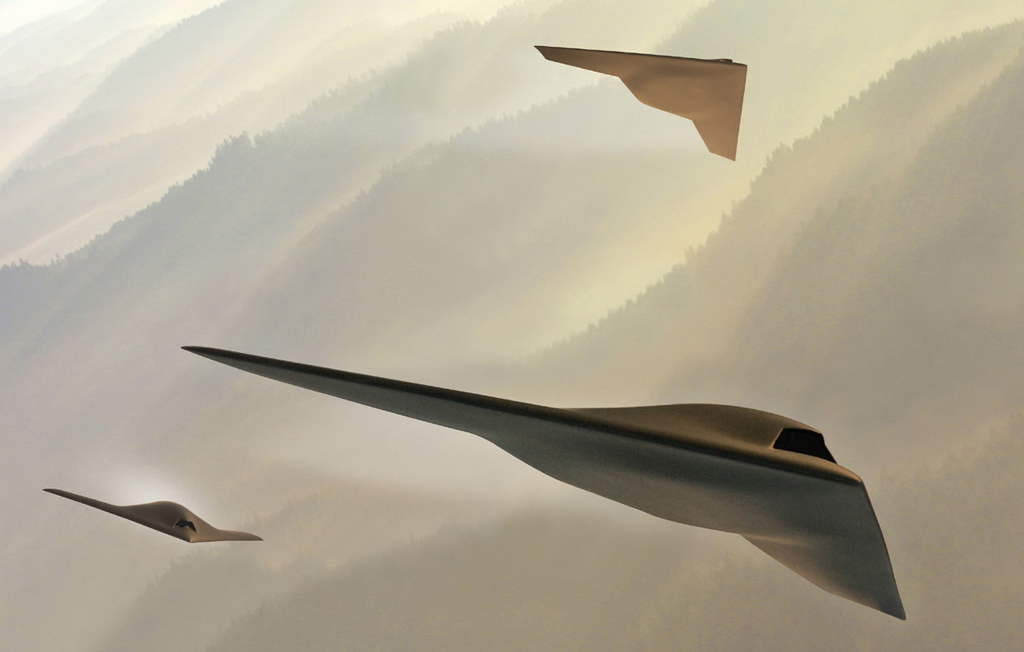
– In many high-risk combat situations a swarm of UCAVs may be far more effective than a large strike package made up of manned aircraft:
A networked swarm of UCAVs has the potential to react to changes on the battlefield at microprocessor speeds. This allows them to totally outpace the enemy’s ability to employ countering tactics and even make decisions. Unlike humans, the swarm has few limits on how much information it can digest at a time and each node (UCAV) within a swarm adds to the quality of its overall situational awareness and effectiveness on the battlefield.
Highly advanced tactics can be employed by the swarm to confuse the enemy and disrupt their ability to defend themselves. This can be done without any traditional radio communications. A directional line-of-sight data-link, such as one similar to the F-35’s stealthy “daisy chain” data-link concept known as Multifunction Advanced Data Link, or MADL for short, could facilitate robust and highly-secure data flow throughout a swarm and even back into friendly territory and then to satellites up above.

Introducing a high-flying connectivity node, an aircraft-based data fusion center and rebroadcasting system, could allow many smaller swarms to be linked together over a vast distance, creating a super-swarm running on what would be akin to a hive mind. Such an increase in communications capability could greatly expand the geographical range, data-exchange capabilities and size of a swarm.
Regardless of its networking scheme, the swarm concept takes the X-45’s DICE software and UCAV autonomy to a whole other level, although the basic nuts and bolts remain the same as they were a decade ago. With a swarm of dozens, or even hundreds of networked UCAVs fighting all at 100 percent efficiency at all times, the enemy is faced with the monumental task of defending themselves against such an efficient, agile and persistent foe.
Advanced tactics, such as multi-vector attacks replete with decoys and jamming, could be executed by the swarm’s best available assets to solve a tactical problem, even an unplanned one. Based on pre-programmed directives, the swarm can instantly vector the right pairing of assets to take out a particular threat or perform a certain task at hand. If that threat is an advanced surface-to-air missile battery, maybe the swarm assigns a pair of Small-diameter Bomb slinging UCAV strikers, one UCAV equipped with electronic jamming systems, and two more to make a decoy attack from high altitude. If the SAM site is less threatening in nature, maybe the swarm sends a single UCAV nearby to drop a JDAM on it, or the swarm avoids it entirely.

There is no magic behind this capability; the swarm’s software would have pre-loaded responses to various stimuli and situations with a certain amount of AI built in to cope with complex scenarios. In a fully autonomous fashion, the swarm will make the decision of how to deal with the threat based on its programming without a human interrupting its onslaught. If they are running in a semi-autonomous fashion they will ask for permission or even direction from a human operator before executing certain tasks. The filer of what task is worthy of asking permission can be set by mission planners before the mission is executed.
For instance, changing a route to avoid an enemy SAM site autonomously may be allowed, while attacking that same site may need permission from a human operator. This method, although maybe politically more accommodating, handicaps the true crushing offensive potential of the swarm. We will talk more about this in a moment.
Redundancy is also a major potential feature of UCAV swarms. If one UCAV gets shot down or malfunctions the swarm just continues on using the assets it has available to achieve the maximum possible effects based on the mission at hand. The loss may degrade the overall fidelity of the swarm’s situational awareness and battlefield “picture,” but it will continue on making the best of the existing resources at hand. In other words, the system is constantly trying to achieve the highest possible efficiency based on its programming and the assets it has available at its disposal. And all of this is done automatically, without traditional communications and human-to-human coordination.
-Air-To-Air may be the swarm’s greatest trick:
For so long UCAVs have been seen as strictly deep strike and surveillance platforms, but when networked together, they could offer an incredible counter-air capability.
Even the subsonic and less than highly maneuverable but very stealthy flying-wing UCAV configurations that we know of today could be absolutely devastating when it comes to sanitizing enemy airspace. The same swarm technology applies to the air-to-air realm as it does to attacking pop-up SAM sites. In fact, under certain circumstances enemy fighters may be an easier threat for UCAVs to deal with than those emanating from the ground.
Enemy aircraft would have a very hard time remaining undetected in airspace that an operational swarm of UCAVs is operating in. Its cloud-like mind will leverage feeds from the multitude of sensors carried by its individual UCAVs, all spread over a wide area. In essence, the swarm acts as is its own virtual AWACS, although in some cases it is far superior as it is forward deployed, can carry a diverse set of sensors spread over a wide area, and the data it collects can be enacted upon instantaneously.

If a potential enemy aircraft is detected, even just for a brief moment, multiple sensors aboard multiple UCAVs can instantly and seamlessly steer their sensors (radar, infrared etc) from multiple angles onto the single piece of sky where the aircraft was. Anti-stealth detection tactics can then be employed, aimed at collectively detecting an aircraft well enough to build a weapons-grade engagement track of it. Working as a team, the swarm can then engage the target in question.
Once a track is established, the best UCAV or UCAVs positioned to deal with it can be assigned the task of doing so, making long-range coordinated missile shots at the bad guy. Instead of using their own radars alone to guide their missile shots, they can use the swarm’s common “picture” to do so.
In other words, the UCAV firing on the enemy aircraft does not even have to use its own sensors to do so as it sees all the other UCAV’s sensor pictures fused together and can use that data instead. This means certain UCAVs, such as those closest to the threat aircraft, can operate “silent,” not emanating any electromagnetic energy. Combined with the UCAV’s wide-band stealthy shape, low infrared signature and radar-absorbent coatings, it is unlikely the target will detect the attacking UCAVs at all. Well at least until their missiles go “pitbull” and lock onto the aircraft during the terminal phase of their attacks, which is likely far too late.
Possessing an extreme level of stealth, both in the radio and infrared spectrum, and having near perfect situational awareness, the UCAV swarm is really a flying pack of telepathic robotic wolves that are all working together to kill the bad guy in a coordinated manner. Having a UCAV even sacrifice itself for the greater good can be programmed as a viable tactical choice.
When it comes to the within-visual-range air combat environment, the current types of UCAVs could never turn successfully with a modern fighter jet. Yet with the latest block of AIM-9X Sidewinder missiles, which are capable of making greater than 180 degree snap turns and locking onto an enemy aircraft after being launched from an internal weapons bay, the UCAV may not have to maneuver aggressively at all.
Then again, avoiding marauding fighters or attacking them with so called “non-kinetic” weaponry would also leverage the UCAV’s unique capabilities. Instead of launching missiles, parts of the swarm could jam and change course to keep themselves outside of the detection range of enemy aircraft. Or they could send pinpoint electronic attacks and pencil-sized high-power beams of electromagnetic energy chirped off by their onboard AESA radars directly at the enemy fighters’ radars and radar-guided missile seekers, blinding, disabling, or destroying them in the process. Even the ability to swat incoming missiles out of the sky with directed energy weapons is clearly on the horizon.

Finally, a fully air-to-air optimized UCAV design may be the most awe-inspiring of all UCAVs as such an aircraft’s maneuverability would not be limited by the crushing gravitational forces a human pilot can endure. As such, a UCAV designed to absolutely rule the air-to-air realm could be able to sustain unheard of G forces, making shooting it down with missiles, or trying to parry it in the within-visual-range air combat realm, nearly useless.
-The ability to leverage common command and control software and human interfaces:
Just as UCAVs can evolve over time via open architecture design and more agile construction concepts, so can their human interfaces and operating software. Strictly speaking, although new UCAV designs may change the look of the swarm, its cloud brain (command logic and acritical intelligence) can continue to evolve linearly. Think of it as buying a new desktop computer but running the same operating system on that is constantly upgraded.
Some of the most expensive and perilous elements of building a new strike-fighter are software development and “back-end” infrastructure related. The nice thing about UCAVs is that its software and command and control elements can evolve over time and can be applied to multiple unmanned airframes used for a whole array of unique missions. These disparate unmanned systems can also have their capabilities more easily interwoven since they run on a common software and control platform.
As a common software suite evolves, the system’s stability, security, and overall capabilities will only increase. This operating system that controls an autonomous swarm can be tweaked and tailored over years, or even over decades, and it can adapt to new threats, tactics and technologies as a whole without having to adapt a series of discreet control systems for separate aircraft designs.

For instance, the same mission software and command and control interface could possibly be used by a large high-flying stealthy surveillance drone made by one manufacturer, while at the same time also used for a swarm of UCAVs made by another. In doing so, these systems could work together seamlessly and flexibly even though their missions and even their manufacturers are different.
One scenario may have that high-flying stealthily drone acting as a super-server and communications relay system that will enable and enhance the awareness and interoperability of a swarm of tactical UCAVs fighting below it. In another scenario, that same high-altitude unmanned aircraft may provide many UCAV swarms, say of six UCAVs each, with moving ground targets it sees on radar to attack from hundreds of miles away. Meanwhile, the same software and interface system could direct low-end unmanned supply drones toward Special Forces units deep in enemy territory, with UCAVs being instantly assigned to protect them on their way.
This “sandbox” like approach could give mission planners and strategists both a mission planning system and a command and control suite for a whole slew of unmanned aircraft all in one neat and ever evolving package.
Think of it as a common operating system that can constantly be improved on and used by new and existing hardware alike. Not only is this concept cost effective and developmentally efficient, but it can greatly enhance the combat capability and flexibility of all the hardware it supports. For mission planning purposes and for being able to leverage the super nimble swarm mentality even further by integrating small numbers of dissimilar and specialized force multiplying unmanned aircraft into it, a common software platform, data-link waveform and command interface will add to the lethality of the swarm as a whole exponentially.
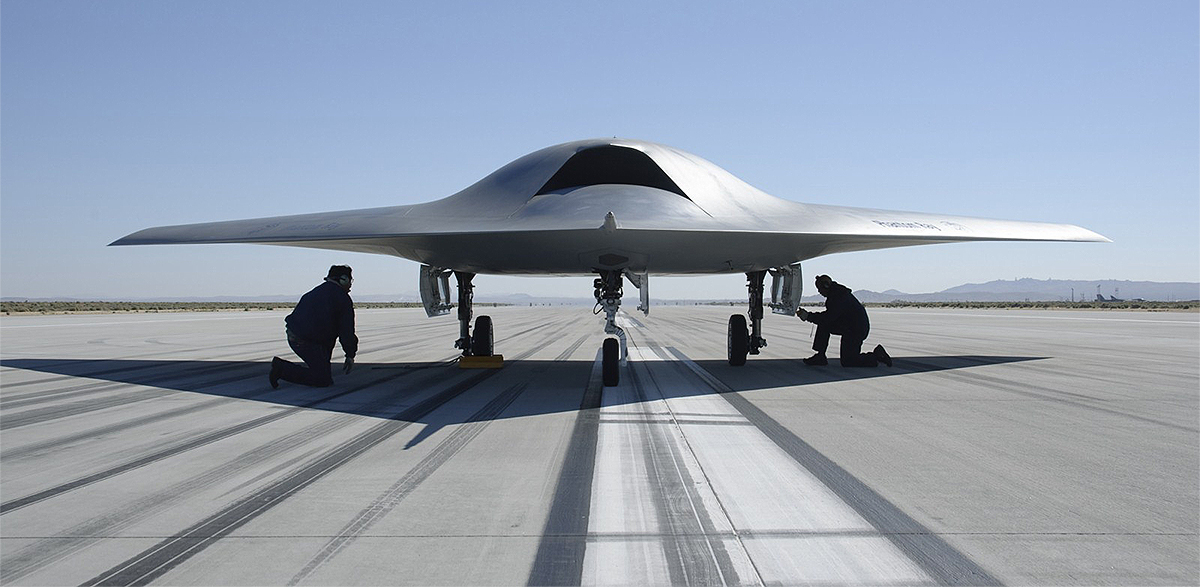
Chapter 9: Hacking and Autonomy Misconceptions
Now that we have discussed many of the potential advantages of UCAVs, let’s talk about their major downside; at least as some see it.
We often hear that hacking and the fear of giving robotic weaponry any level of autonomy is a barrier to widespread UCAV procurement. In some cases these issues are paired together with Terminator like hyperbole that really does sound frightening. The fact is that autonomy will become a reality far sooner than most think it will, regardless of if we like it or not. The simple reason is that autonomy unlocks the UCAVs true potential; being able to act quicker than any human could, especially while working as part of a swarm.
America has been spoiled by picking its wars on its own terms since the latter half of the 20th Century. In the future it is highly unlikely we will be so fortunate. If a conflict were to erupt between the US and a near-peer state competitor, the last thing we will be worrying about is if a UCAV hit the wrong target accidently or not. That may sound callous, but the stakes will be far too high for holding back winning capabilities due to fears over not having a human directly approving ever target a UCAV hits.
There are also many levels of autonomy. At its most basic level, UCAVs could be used to hit fixed targets deep in enemy territory, with the only decisions made by the aircraft itself being how to evade enemy air defenses on its way to and from the target. This type of capability is on par with the current “smart” cruise missile technology of a medium capability level, the big difference being that you can reuse the UCAV and it can hit multiple targets on a single mission. As such, the fear that a human is not “in the loop” controlling a UCAV on such a basic mission is irrelevant as the same arguments can be made about cruise missiles that have been in used for decades.
As you move up the autonomy and mission complexity ladder, you hit the point where the UCAV is not going after fixed targets but is actually deciding to prosecute targets of opportunity on its own. This starts with taking out air defense-related threats that put the vehicle or its swarm in danger.
At its most rudimentary level this is initiated by external stimulus, such as a SAM site’s radar, or air defense node’s electromagnetic emissions being detected by UCAV. The UCAV can classify and triangulate these signals just as the F-22 or F-35 can, and a swarm can do it with exceptional ease and precision due to the wide geographic spacing between each node and the swarm’s data-fusion capabilities. Algorithms pre-programmed into the UCAV’s brain (or brains in the swarm’s case) would theoretically allow it or them to decide whether to avoid, deploy electronic attacks to blind or confuse the threat system, or to destroy it using kinetic weaponry. Factors such as the swarm’s primary mission, intended targets, flight path, stores and fuel state of each UCAV, mission timing and the type of threat being detected can all go into the automated decision making process as to how to best deal with the situation. All this happens in an instant of course and with maximum efficiency as we have mentioned before.
The next step in UCAV autonomy is to not just respond independently in a reactionary manner to unplanned threats that emit threatening electromagnetic energy, but to pursue targets that may not threaten the UCAV or its swarm at all. Using synthetic aperture radar, multi-spectral optical and infrared sensors,ground moving target indication (GMTI) radar and external sensor feeds from non-swarm aircraft, a UCAV or a UCAV swarm can hunt for targets of opportunity on their own.
Image and 3D object matching can be used to identify and classify valid targets that the UCAV or swarm detects. This data is stored in the UCAV itself and/or in the swarm’s cloud-like data library. After it classifies the target as valid, and it exists in an area pre-selected as a free fire zone by mission planners, the UCAV swarm could then select the best munition and asset to destroy it. Imaging and 3D model matching is already used on advanced cruise missiles successfully today, and it will be increasingly a staple of other modern air-to-ground munitions. With this in mind, and regardless of what some may tell you, it is not as if these things (UCAVs) would just being released on their own accord to blast away at any blips on a radar screen, there is much more to it than that.
Under the semi-autonomous concept of operations, the UCAV would have to ask a human operator if it can attack the target it found on its own. At the very least, radar, infrared or optical imagery of the target and its location would have to be transmitted to the operator as part of the attack approval process. This may be fine for medium and lower threat environments, but for high-threat ones, where two-way communications could open the UCAV, and the swarm for that manner, up to detection and electronic attacks, such a concept could be problematic.
One theoretical solution to this issue would be a daisy chain-like line-of-sight data-link that passes information between UCAVs operating deep in enemy airspace and back over the horizon to less contested territory. Once there, the swarm’s data can be sent to satellites and replies can be sent back down and be passed forward along the same chain of communications. This means the swarm would not be emitting data to anything but its own kind using very hard to intercept or jam directional data-link. By using the daisy chain concept, and the UCAV’s long loitering capabilities, the swarm could still benefit from two-way communications to controllers around the globe without putting themselves at elevated risk of being detected, jammed or even hacked.
Another theoretical solution would be to data-link this info up to a high-flying unmanned aircraft that can then use advanced satellite, or long-range direct communications capabilities to send it wherever it needs to go. Still, either method slows down and handicaps the swarm’s ability to rapidly bring devastation on the enemy.
Under the fully autonomous concept of UCAV operations, the UCAVs will not ask anyone if they can attack a target or not. They will decide on their own based on the software they are operating with. This allows the swarm to work at blistering speed, overwhelming and shattering the enemy’s decision cycle. It sounds scary, but remember that these craft are built to dismantle the enemy’s ability to fight on the first days of war, and once again, to some degree autonomous targeting is already being used by advanced land-attack and anti-ship cruise missiles.

As far as network security goes, a closed network that only broadcasts directionally to other UCAVs within line-of-sight, once again the daisy chain method is thought to be very secure and has a very low probability of detection or intrusion. This is why it is being used for the F-35’s data-link. It also allows for a higher quality of situational awareness even when satellite communications over enemy territory are denied.
If for whatever reason the swarm’s network is shattered or degraded, the individual UCAV components can default to accomplishing their mission by breaking into smaller swarms with more stable, closer-range communications or going it alone with the information they have available. In fact, UCAVs, whether in a swarm or not, will benefit from external third-party targeting and surveillance information just like manned fighters increasingly do. This comes in the form of data-link feeds from standoff surveillance systems including AWACS, JSTARS, and ground-based and sea-based radar systems. In receive only mode, stealthy UCAVs can benefit from this information without opening themselves up to sending out emissions that could be detected. F-22s and F-35s can benefit from this one-way data link concept as well. In fact, the F-22 does today as it can see Link16 information, it just can’t broadcast its own sensor picture without help from an external data-fusion gateway.
The truth is that UCAVs don’t have to talk to anyone at all. If need be, and under the simplest concept of operations, they can fly to a certain point outside enemy territory, and shut off two-way communications entirely, crossing into enemy territory emissions silent. They then go about their missions, reacting to threats around them via passive detection systems. Once they have left enemy airspace, they can once again communicate with their human masters via satellite unencumbered.
This “go it alone in silence” concept is absurdly secure from am electronic attack and hacking standpoint, and the UCAVs can be programmed to only open up communications during their mission under certain conditions that are programmed internally. These can include reporting loss of engine power or other serious malfunctions. But once again, during their time near enemy territory they can be totally firewalled from the outside world, just as the F-117 had been during its combat operations in the Middle East and Europe. Sure they won’t be able to benefit from being integrated into a swarm, but when maximum network security is warranted, this method of operation is available.
The great thing about UCAVs is that a single vehicle could be built to operate semi-autonomously, autonomously, as part of a swarm or all alone depending on their mission and the threat environment they will be operating in. So separate vehicles would not have to be built for these separate modes of operation.
For operations over a third world country with a medium quality air defense system and a low chance of network disruption, UCAVs could work as a swarm and/or in semi-autonomous fashion. For the opening strikes on a highly capable foe they can degrade the enemy’s ability to fight by hitting only fixed targets while fully firewalled from the outside world, and then move to autonomous, fully networked swarm operations to wreak maximum havoc on the enemy once their electronic warfare abilities have been degraded. Because they would likely use a similar concept of communications, and are both heavily reliant on automation, a swarm is likely to be just as resilient to cyber attack as the F-35.
Chapter 10: Tethering is not a replacement for the swarm
There is lots of talk about “tethering” unmanned air combat aircraft with manned aircraft, where a unmanned combat drone basically works as a manned fighter or bomber’s robotic wingman. This just moves the semi-autonomous control of the unmanned component from a ground station halfway around the globe to a cockpit right over the battlefield. This concept has its merits, but it is no replacement for an autonomous swarm, not even close.

Such an idea, where an aircrew assigns an unmanned combat aircraft that is paired to them to go do this and to fly there, or to attack this target or jam that one, would be very useful for the crew that is directing it. Yet the man-in-the-loop operating concept still limits the UCAVs potential just as it would if the operator were sitting in a ground control station three thousand miles away. The only thing that changes is that the communications could be much harder to detect, jam or attack because a directional line-of-sight data-link could be used instead of satellite communications. Additionally, the drone would be slaved to the aircrew’s needs, not part of a larger coordinated swarm.
Simply put, the utility of such a UCAV concept is discreetly different than an all-unmanned concept, and it is a good route to explore. The nice thing is you can built a fully autonomous UCAV that can just as easily be used for a semi-autonomous tethered mission one day and fly as part of an autonomous swarm the next.
Surely tethering unmanned systems to manned fighter and attack aircraft is a big force multiplier. It means more tactical flexibility, more weapons at an aircrew’s disposal and less risk to them for certain combat tasks. But it is not a technological game-changer like an autonomous UCAV swarm would be. So no, the ideas are not interchangeable but they are definitely complimentary.
But once again, the nice thing is that a UCAV swarm can do its thing on its own for the opening days of an air campaign, and then once manned fighters are introduced into the conflict, UCAVs can join them as dynamic wingmen or just a weapons mule. You only have to buy one UCAV to do both things and the concept will lend itself well when it comes supporting close air support missions after the UCAV swarms have kicked down the enemy’s front door.

Chapter 11: The USAF comes up with another UCAV initiative and quickly drops it with prejudice
Following the USAF’s sudden abandonment of the J-UCAS program, years of nothing followed. Eventually an initiative for what seemed to be a very basic UCAV capability was softly launched by the USAF under the moniker of MQ-X. This program never even made it past the requirements stage and was cancelled with prejudice in 2012.
During this same timeframe, Boeing, which held onto its UCAV dreams into the current decade, built a full sized UCAV demonstrator, dubbed the X-45C Phantom Ray, to continue on proving the UCAV concept. This was largely an internally funded affair, with the aircraft flying for the first time in 2011. Although the vehicle seemed promising, the USAF seems to have shown no interested in it at all. With Northrop Grumman haven flown the X-47Bs on their high-profile test missions for the Navy, and Lockheed at least having the RQ-170 under its belt and who knows what else, Boeing, whose X-45A demonstrators and DICE software were so promising a decade ago, seems to be left out in the cold when it comes to anything UCAV related, at least for now.
At the time the MQ-X cancellation was announced, Lt. General Larry James stated the following:
“Given the requirement set, given what’s going on in the world out there with the Reaper fleet, that we can upgrade those as we need to, to meet the demand signals, to meet the requirements that are going to be out there in the future… The Navy is developing some capability in the UAV domain, we want to see how that play out before we make any decisions on any next-generation platform capability… So as I said, in the near term, right now, there is no intent to pursue that MQ-X program.”
So what happened here? Was the MQ-X an initiative for the USAF to procure a lower-end, more openly deployable UCAV than a more highly advanced one that already exists in the black program world? Was it a cover of some type? Or even worse, was it an indication of where the USAF actually stands developmentally when it comes to deploying operational UCAVs, which is seemingly nowhere, at least publically. Maybe the strandgest thing is that according to General James, we are supposed to believed that the USAF actually chose to follow the Navy in regard to UCAV development, which is almost a laughable proposition to say the least. Then again, maybe the USAF is in total denial of what this technology represents.
Chapter 12: If we don’t dominate this space someone else will, and soon
The fact is that if we don’t aggressively field this technology our potential enemies, who give far less consideration when it comes to the morality of robotic warfare, will. In fact, Russia and China both have ongoing UCAV programs, and although they remain in a fairly immature state and their sub-systems and low-observable designs are likely quite far behind American capabilities, they will steadily improve. Additionally, quantity is a quality all its own when it comes to UCAV swarms. Just because a foe can’t build the best UCAV imaginable doesn’t mean a large force of inferior types is not a potentially very deadly threat to say the least.

Right now, by all indicators the US is leading in the unmanned aircraft department and especially in the low observable (stealth) one. Yet European consortiums have begun to let the UCAV genie out of the battle, with the highly promising BAE Taranis and the Dassault-led nEURon program rapidly evolving, the US has a grand but limited window of opportunity to pull away fully from the pack when it comes to this technology. And this won’t happen keeping the technology buried in the black world or not pursuing it really at all.
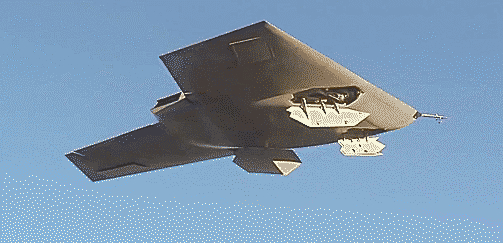
Chapter 13: The truth hurts either way
The idea that the USAF has chosen not to procured UCAV technology in any sort of meaningful scale at all, beyond maybe some classified technology demonstrators, even a decade after the UCAV’s potential was so brilliantly demonstrated by the X-45s, sounds so troubling it borders on shameful. Yet the USAF has, to put it far too nicely, struggled greatly when it comes to integrating unmanned programs into its flyboy dominated culture.
The idea that an unmanned system could make at least some of the USAF’s manned tactical aircraft totally obsolete, even before they are built, strikes right at the heart of the USAF’s fighter pilot cabal. With this in mind, could the Air Force brass have stubbornly kept UCAVs at bay in order to protect the role of aircrews within the flying service? Especially considering that this new technology could directly threaten not only the biggest weapons program of all time, the F-35, but the last manned fighter the USAF may ever actually buy.
Given the evidence, or lack thereof, It seems possible.
Such a move would be incredibly near-sighted. Considering America’s dulling combat advantage, especially in the aerial warfare department, not pursuing UCAV technology may have mortgaged national security for the personal and professional biases of key Pentagon power brokers, along with an overwhelming cultural norm that may be incompatible with the idea of fully unpiloted combat aircraft.
The fact is that there has never been a more critical time for the US military to leapfrog its potential enemies technologically than right now, and UCAVs could do just that. We continue to stubbornly run the same old fighter development race with our potential foes, which is one expensive game to play. The sad part is that UCAVs offer America a great opportunity to disrupt the strategic paradigm instantly by starting to play an entirely game altogether, one that our potential foes are far less prepared to play, at least for the foreseeable future.
The USAF could flex a sizeable portion of its resources into advanced UCAV development and procurement, throwing our peer state competitors down the developmental cliff in the process. To put it simply, if we are no longer enjoying vast superiority in manned tactical aircraft capabilities vis-à-vis our potential foes, than why continue down that path when we have the ability to leap in another direction completely?
So there you have it. Either the USAF has a secret UCAV capability, but only in relatively tiny numbers, which handicaps many of the concept’s innate advantages, or the alternative is even worse; the USAF has not pursued the technology to any significant degree at all. Even if the better of these two possible realities is true, the veil of secrecy surrounding such a classified UCAV program has likely resulted in highly skewed procurement and strategic decisions that we may not be able to recover from for many decades.
In the end both theories result in a nation that is less well defended than it would be with a large-scale and disclosed UCAV program underway and the longer this game-changing technology remains buried or undeveloped for whatever reason, the worse off America will be.
Contact the author Tyler@thedrive.com
